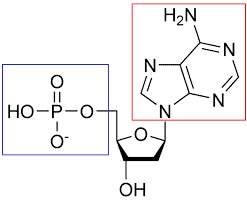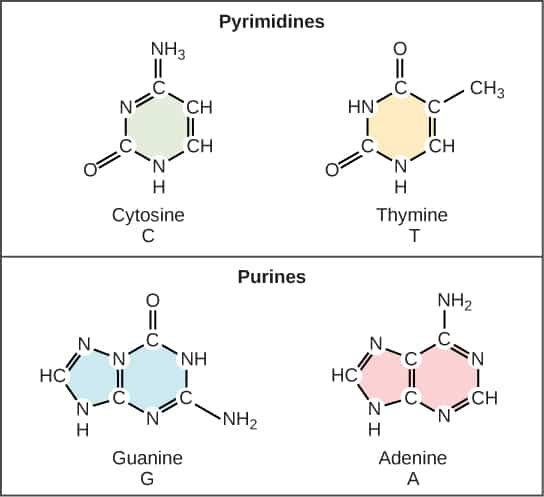Watson and Crick DNA Structure and Function
DNA or deoxyribonucleic acid is a long molecule that contains our unique genetic code. it contains the instructions to produce all the proteins in our body.
Contents
DNA components
DNA consisted of subunits called nucleotides. A nucleotide is formed by
- sugar (deoxyribose)
- phosphate group
- one of the four nitrogen bases: adenine (A), thymine (T), guanine (G) or cytosine (C).
Bases C and T, which have only one ring, are called pyrimidines, while bases A and G, which have two rings, are called purines.

DNA nucleotides are assembled in chains connected by covalent bonds, which are formed between the deoxyribose sugar of one nucleotide and the phosphate group of the following. This arrangement forms an alternative chain of sugar and deoxyribose phosphate groups in the DNA polymer, a structure known as the main chain of sugar and phosphate.
The DNA model of Watson and Crick
The structure of DNA is a double-stranded, anti-parallel and right-handed helix. The main sugar and phosphate chains of the DNA chains form the outside of the helix, while the nitrogen bases are inside and form hydrogen-bonded pairs that hold the DNA chains together.

DNA nucleotides
The basic components of nucleic acids are nucleotides. The nucleotides that make up the DNA are called deoxyribonucleotides. The three components of a deoxyribonucleotide are a five-carbon sugar called deoxyribose, a phosphate group, and a nitrogen base, a nitrogen-containing ring structure that is responsible for linking complementary bases between nucleic acid chains. The carbon atoms of the five-carbon deoxyribose are numbered 1ʹ, 2ʹ, 3ʹ, 4ʹ, and 5ʹ (1ʹ reads as “a cousin”). A nucleoside includes sugar with five carbon atoms and the nitrogen base.

Deoxyribonucleotide is named according to the nitrogen bases. The nitrogen bases adenine (A) and guanine (G) are purines; They have a double ring structure with a six-carbon ring fused into a five-carbon ring. Pyrimidines, cytosine (C) and thymine (T), are smaller nitrogen bases that only have a ring structure with six carbon atoms.
Base pairing
In the Watson and Crick model, the two strands of the double DNA helix are held together by hydrogen bridges between nitrogen bases on opposite strands. Each base pair is flat and forms a “sport” on the ladder of the DNA molecule.
A combination of bases does not form base pairs. However, if an A is found in one chain, it must be linked to a T in the other (and vice versa). Similarly, a G in a chain must always have a C for a partner in the opposite chain. These associations A-T and G-C, are known as complementary base pairs.
DNA function
- DNA stores the information needed to build and control the cell. The transfer of this information from stem cells to daughters is called vertical gene transfer and takes place via the DNA replication process. DNA is replicated when a cell duplicates its DNA, then the cell divides, resulting in the proper distribution of a copy of DNA to each resulting cell. DNA can also be enzymatically degraded and used as a source of nucleosides and nucleotides for the cell. Unlike other macromolecules, DNA has no structural function in cells.
- DNA polymers direct the production of other polymers called proteins.
A protein is one or more polymers of monomers called amino acids. Proteins are the molecules of the workhorse in their cells. They act as enzymes, structural support, hormones and a large number of other functional molecules. All properties are derived from the interactions of proteins with each other and the surrounding environments. - A chromosome consists of smaller segments called genes.
Chromosomes are very long structures that consist of two DNA polymers, connected by hydrogen bonds that connect complementary base pairs. A chromosome is divided into segments of double-stranded DNA, called genes. - Each gene is divided into three subsets of nucleotides called codons
A codon is a segment (or piece) of double-stranded DNA with a length of three now.







